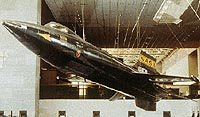|
|
||||||||||||||||||
The North American X-15, a rocket-powered research aircraft, bridged the gap between manned flight in the atmosphere and space flight. After its initial test flights in 1959, the X-15 became the first winged aircraft to attain hypersonic velocities of Mach 4, 5, and 6 (four to six times the speed of sound) and to operate at altitudes well above 30,500 meters (100,000 feet). The X-15 was carried to an altitude of 12,000 meters (40,000 feet) under the wing of a Boeing B-52 bomber. During one test, it attained an altitude of over 108 kilometers (67 miles), flying so high that it functioned more as a spacecraft than an airplane. In 1967 it reached Mach 6.72 (7,297 kilometers or 4,534 miles per hour). The X-15 was designed to explore the problems
of flight at very high speeds and altitudes. The X-15 and other
research aircraft contribute to the advancement of aerospace technology.
Design Features: The wedge-shaped tail surfaces of the X-15 provided directional stability at speeds where conventionally shaped airfoils would not be effective. The large upper and lower fins and the downward slant of the wings enabled the aircraft to remain stable during steep climbs and at high altitudes. The substructure of the X-15 is titanium with a covering of Inconel X, a nickel alloy capable of withstanding temperatures of 650° (1,200°). The black color of the aircraft helped to dissipate heat, and the gaps along the fuselage closed as the external temperature increased. The small holes near the nose are for attitude control jets, used at very high altitudes where airfoil surfaces no longer provide aerodynamic control.
More Information: |
![]() 1958
Explorer 1 | Milestones of Flight | 1962
Mercury "Friendship 7"
1958
Explorer 1 | Milestones of Flight | 1962
Mercury "Friendship 7" ![]()
©National Air and Space Museum
